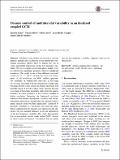Oceanic control of multidecadal variability in an idealized coupled GCM
Author(s)
Jamet, Quentin; Huck, Thierry; Arzel, Olivier; Campin, Jean-Michel; de Verdière, Alain Colin
Download382_2015_Article_2754.pdf (2.603Mb)
PUBLISHER_POLICY
Publisher Policy
Article is made available in accordance with the publisher's policy and may be subject to US copyright law. Please refer to the publisher's site for terms of use.
Terms of use
Metadata
Show full item recordAbstract
Idealized ocean models are known to develop intrinsic multidecadal oscillations of the meridional overturning circulation (MOC). Here we explore the role of ocean–atmosphere interactions on this low-frequency variability. We use a coupled ocean–atmosphere model set up in a flat-bottom aquaplanet geometry with two meridional boundaries. The model is run at three different horizontal resolutions (4°, 2° and 1°) in both the ocean and atmosphere. At all resolutions, the MOC exhibits spontaneous variability on multidecadal timescales in the range 30–40 years, associated with the propagation of large-scale baroclinic Rossby waves across the Atlantic-like basin. The unstable region of growth of these waves through the long wave limit of baroclinic instability shifts from the eastern boundary at coarse resolution to the western boundary at higher resolution. Increasing the horizontal resolution enhances both intrinsic atmospheric variability and ocean–atmosphere interactions. In particular, the simulated atmospheric annular mode becomes significantly correlated to the MOC variability at 1° resolution. An ocean-only simulation conducted for this specific case underscores the disruptive but not essential influence of air–sea interactions on the low-frequency variability. This study demonstrates that an atmospheric annular mode leading MOC changes by about 2 years (as found at 1° resolution) does not imply that the low-frequency variability originates from air–sea interactions.
Date issued
2015-07Department
Massachusetts Institute of Technology. Department of Earth, Atmospheric, and Planetary SciencesJournal
Climate Dynamics
Publisher
Springer Berlin Heidelberg
Citation
Jamet, QuJamet, Quentin et al. “Oceanic Control of Multidecadal Variability in an Idealized Coupled GCM.” Climate Dynamics 46.9–10 (2016): 3079–3095.
Version: Author's final manuscript
ISSN
0930-7575
1432-0894